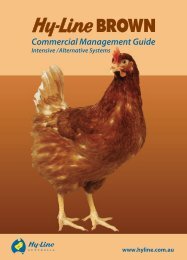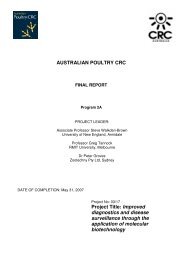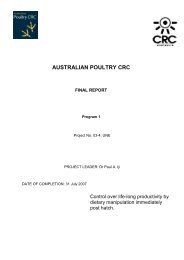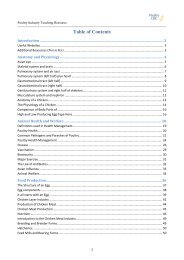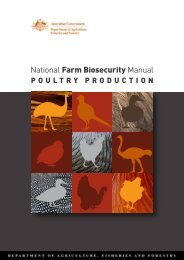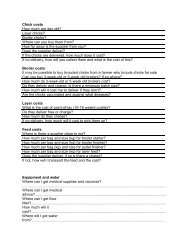AUSTRALIAN POULTRY CRC - Poultry Hub
AUSTRALIAN POULTRY CRC - Poultry Hub
AUSTRALIAN POULTRY CRC - Poultry Hub
- No tags were found...
You also want an ePaper? Increase the reach of your titles
YUMPU automatically turns print PDFs into web optimized ePapers that Google loves.
act as mechanical vectors of other bacterial infections. All flocks in the current survey were found tobe infected with roundworms.It has been known that a variety of bacteria such as coliforms, staphylococci, streptococci, pasteurella,and salmonella may infect birds of any age and cause local infections of the ovary in adult chickens.Oophoritis, salpingitis, and salpingoperitonitis are prominent feature of several viral and bacterialdiseases and are associated with reduced egg production and/or poor eggshell quality (Riddell, 1996).Mycoplasma gallisepticum, E. coli, Salmonella spp., P. multocida, Staphylococcus aureus, havefrequently been isolated from lesions in the peritoneum and reproduction tract of laying chickens(Gross and Siegel, 1959; Sudhir et al., 1968; Grimes, 1975; Jones and Owen, 1981; Riddell, 1996;Trampel et al., 2007).Apparently, systemic and local immunity (of the oviduct and ovary) play significant roles in thedefence against primary infections and in the control of opportunistic bacteria normally living in thepoultry environments. Locally secreted cytokines and chemokines might also affect the function ofreproductive organs leading to ovary and oviduct dysfunctions.It was concluded that, reproductive lesions often may cause drops in egg production and sudden andnumerous death in laying hens. This has causes significant economic losses to producers and mightaffect the welfare of birds in free range.Cannibalism was the second most common cause of morality. The reproduction tract lesions havebeen in most of cases associated with a dirty cloacae and vent, therefore leading to pecking andcannibalism. Pecking at the vent would also lead to the spread of the bacterial infection. Diseasedhens attract cannibalistic pecks which could explain a reported correlation between infections of thereproductive tract and pecks to the cloacae (Randell et al., 1977). Care must be taken to separatecause from effect, since cannibalistic attacks may also predispose surviving victims to subsequentinfection.General DiscussionThe nationwide survey questionnaire return rate was disappointing with only fourteen producersreturning completed surveys. The survey was developed in consultation with free range producers andan opportunity for the industry itself to have a major input into the direction of free-range research inAustralia. Publicity included letters to industry associations and handouts at PIX and the survey wasdistributed through either state free range associations, producer groups or to individual producers.With surveys distributed through associations or producer groups we were reliant on them to informtheir members of the survey and to ensure each member received a copy of the survey. Problems withthis included the sending of surveys to all egg producers in a state regardless of production system.This makes it extremely hard to get an accurate measure of the number of free range producers in thatstate and to be able to follow up with these producers and remind them to complete the survey and thatthere is an extension. Some surveys were returned from producers who had not had free range layersfor years however they were still on an association or producer group list. The other problemencountered was the topic that was being surveyed. Comments returned included „difficult type ofsurvey – like have you got aids‟, „suspect you will only get the good ones as the other might not wantto know/admit they have high chook mortalities‟ and more than once „don‟t want the cage big boys touse this information against us‟. The fact that not every egg production system was being surveyedcaused concern that we were unfairly targeting the free range industry and therefore in turn helping thecage layer industry. Every assurance was given that the survey and project as a whole was to help thefree range industry (and in fact, the industry asked for some research to be done) and confidentialitywould be paramount however there seems to be some level of distrust.Reasons for a low response to a survey can include confusing questions; a format that is not consistentand is unprofessional; telephone surveys (especially with the growth of telemarketing); no follow upand not letting people know the survey is to be conducted. The nationwide survey was widely29



